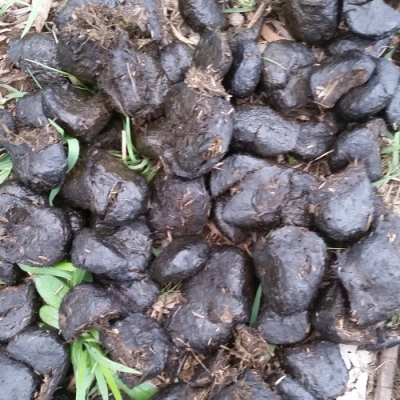
Horses naturally eat quite a bit of soil. Under normal circumstances there is sufficient fibre moving through their gut to move the sand and dirt through their gut and out in their manure… so normally it won’t accumulate too much. During drought however, due to grazing very close to virtually bare ground the amount of soil they eat increases, while often the amount of fibre they have to eat is reduced. So drought is a double whammy… more sand and dirt in their gut and less fibre to carry it through. This situation often results in accumulation of sand and dirt, which can cause irritation of the gastrointestinal tract and result in colic or diarrhoea.
A simple home test for the level of sand is the glove test. Using big clear gloves (vet rectal exam gloves are good), put several lumps of manure in the glove with plenty of water. Massage the glove until the manure is all broken up, then hang the glove to allow it to settle. Check the fingers of the glove to see how much sand falls to the bottom. If you don’t have gloves, you can do the same with a clear plastic bag, tipping it so one corner is at the bottom when leaving it to settle.
If there’s less than 1 teaspoon in total then generally there’s no need for concern. If more than that, do another test in a couple of days to confirm the results, then check with your vet if you need to take additional action.
The best way to clear sand and dirt from a horse’s gut is to feed lots and lots of hay. During a drought this isn’t always possible as hay supplies get shorter and shorter. An alternative and also quite effective way of clearing it is to feed psyllium husk. Psyllium husk is a fibre that absorbs water in the gut and turns into a really sticky goo that will stick to the sand and dirt and move it out of the gut.
Epsom salts will increase the cleaning action by attracting even more water to the intestines as it passes through.
We found an interesting research paper here showing significant sand and dirt accumulation being successfully shifted in 4 days using a combination of psyllium husk and Epsom salts. The action of the 2 together appeared to be significantly better than either by themselves. Care needs to be taken though to limit the use of Epsom salts to short periods as it can have an irritant effect on the gut with prolonged use.
The study was primarily testing with nasogastric tubing however does state that previous studies have shown there didn’t appear to be a significant difference in effect between tubing or feeding. Recommended feeding rate from our vet is 50 grams per 100 kg of bodyweight of psyllium husk and 10g per 100kg of Epsom salts per day, for maximum 5 days at a time.
Feed it in a single meal, for 5 days in a row, mixed with something your horse loves the taste of. Make the feed very slightly damp then put in the psyllium and Epsom salts and mix it around. Don’t make it too wet as many horses don’t like the taste and/or texture of wet psyllium. If your horse was showing signs of sand or dirt accumulation (mild colic or diarrhoea), give the horse a break for 5 days and then repeat the 5 day treatment.

Debbie is the founder of My Horse Supplies. She has had a lifelong love affair with horses. She currently runs an agistment centre, as well as caring for nearly 20 of her own horses.